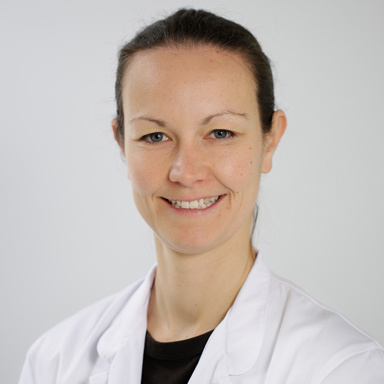Sleep apnoea syndrome occurs when there are episodes of apnoea (short periods where you stop breathing) during sleep. These episodes occur very frequently and briefly interrupt the person’s sleep. Those affected do not usually notice any of this; however, they suffer from pronounced daytime sleepiness as a result of their disturbed sleep.
Doctors differentiate between obstructive sleep apnoea syndrome and central sleep apnoea syndrome. Central sleep apnoea syndrome is rare and related to a disorder in the respiratory centre of the brain. The respiratory centre manages our sleep. However, most cases of sleep apnoea syndrome involve the obstructive form. It causes closure (collapse) of the airway as a result of muscle slackness in the throat during sleep. Men are twice as likely to suffer from it as women. It is estimated that more than 150,000 people suffer from obstructive sleep apnoea syndrome in Switzerland. The exact causes of obstructive sleep apnoea syndrome are not known. Genetic factors seem to play a certain role as there is often a familial predisposition to the disease. In addition, there are some risk factors which facilitate the occurrence of sleep apnoea syndrome. Besides the male gender, excessive weight with a large neck circumference, tight throat conditions, smoking and alcohol intake before sleep as well as the age are among the known risks.
People who suffer from sleep apnoea syndrome are also loud snorers. Snoring and sleep apnoea syndrome are closely linked to one another. Those affected do not usually notice these periods of apnoea during their sleep. They are usually made aware of it by their spouse or life partner. A major symptom of sleep apnoea is daytime tiredness. This can vary in severity from person to person. It is not uncommon to doze off during the day and can be particularly dangerous while driving. Many of those affected also have headaches and difficulty concentrating.
These periods of apnoea are not life-threatening. However, they cause fluctuations in the oxygen content in the blood, metabolic disorders and strain on the cardiovascular system. Sleep apnoea syndrome is therefore a significant risk factor for high blood pressure and cardiovascular disease.
Those affected often suffer from sleep apnoea syndrome for years before the disease is detected. Information from your spouse or life partner about these periods of apnoea or chronic tiredness should therefore be taken seriously and checked by a doctor. Your breathing at home while sleeping can be recorded with a special device and sleep apnoea syndrome diagnosed. Depending on the situation, additional examinations in a sleep laboratory are sometimes required.
The most effective treatment of obstructive sleep apnoea syndrome is pressure ventilation with a nose mask. With this CPAP (continuous positive airway pressure) method, a mild air stream is directed into the airway via a mask. It causes the periods of apnoea, the sleeping disorder and the snoring to disappear. Those affected usually get used to the mask very quickly. An alternative therapy is the mandibular advancement splint.
A further important component of the treatment is avoiding and reducing the risk factors. In other words, no alcohol at least 2 hours before going to bed and weight loss if you are overweight. Mild forms of sleep apnoea can sometimes be fixed just by taking such measures.
Centres 3
-
Klinik St. Anna Lung Centre
St. Anna-Strasse 32 6006 Luzern

